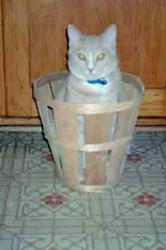Upcoming Events
Check Out What's Going on...
Support Fairchild on Amazon
http://smile.amazon.com/ch/43-
HELP US RAISE MONEY BY JOINING iGive.com
REDNERS Save-A-Tape Receipts Help CatS!
Present your Redner's Rewards Card to the cashier at checkout. The cashier will scan your card, which will enable your register receipt to be counted toward the Save-A-Tape program. Redner’s will donate 1% of the earned Save-A-Tape $ dollars to Fairchild!! WE NEED THE WHOLE RECEIPT and no receipts older than 3 years will be accepted.
Mail to the Fairchild Foundation @
330 West Main Street, Birdsboro, PA 19508
SHOP @BOYERS? Stop by to get a Key Card and 1% of your shopping goes to Fairchild just by swiping your card!
3rd Sunday of the Month January - November
Feral Cat Spay/Neuter Clinics
at THE VET ON MAIN
330 West Main Street....the back of the hospital building
For Appointments Complete our online reservation form www.fairchildcat.org/clinics
**ADMIT: Arrive between 9-11 am by Appointment.
All cats MUST be admitted in a Humane Box Trap or Transfer Cage for safety purposes.
You must also bring a hard plastic pet CARRIER with TWO TOWELS for recovery & discharge for EACH cat.
Write your LAST NAME (or colony name) AND Cat's Name
on masking/duct tape and affix it to the carrier, towels trap, and trap cover.
$10 CASH donation is required at the clinic for each cat
Questions: Email fairchildfoundation@gmail.com
**Help Your Pet Lose Weight**
Hill's & Banfield have teamed up together to help your Pet be THE BIGGEST LOSER. Stop by for your FREE Measuring Cups while supplies last. Just remember the portions on the bag are MORE than your Pet really needs to eat.
Weight Loss Trick: Get your pet to eat SLOWER...for cats and small dogs use a 20-ounce empty plastic soda/bottle and for medium and large dogs use a 2-Liter bottle. Simply DRILL holes in the empty (clean and dry) bottle that are slightly bigger than the kibble. Put your pet's ration in the bottle and close the lid. Now your pet has to ROLL the bottle around to get the kibble to come out of the holes...it's fun and rewarding!
Take a walk with your pooch--both of you will benefit from the exercise.
Substitute VEGGIES & Fruits for fatty treats...Carrots, green beans, broccoli, canned pumpkin, sweet potatoes, apples (no seeds), cranberries, blueberries, watermelon and canteloupe all make great treats!!
Visit www.petfit.com for more diet and exercise tips
REVOLUTION now available for Cats...topical heartworm prevention, flea control, deworming and ear mite medication in ONE easy TOPICAL application!
Screen your Dog for Heartworm, Lyme and Ehrlichia Diseases Today!! Results in 10 minutes while you wait! Both Heartworm Lyme Disease arevery common and can be crippling to your pet as well as life-threatening if left untreated. Yearly testing is recommended. Heartworm testing also available for cats!!
For more information on Heartworm Disease visit www.heartwormsociety.org and www.knowheartworms.org

TOP 10 TIPS FOR A LIFETIME OF GOOD HEALTH FOR YOUR PET from the ASPCA
1. SPAY OR NEUTER
Talk about preventive medicine! Removing the ovaries and uterus of a female dog or cat—otherwise known as spaying—helps prevent breast cancer and pyometra, or infection of the uterus, and stops the animal from going into heat. (Female cats, by the way, can go into heat every 3 weeks!) And ASPCA experts believe that many aggressive behavior problems can be avoided by neutering a male, or removing the testicles, by the age of six months. The surgery also prevents testicular cancer, prostate disease and hernias.
2. VACCINATE
When your pet was born, he received protection from many diseases from antibodies passed in his mother’s milk. These antibodies dissipated by the time he was about three months old, leaving his immune system vulnerable. That’s where you come in. The ASPCA recommends that cats receive a three-in-one vaccine that protects against feline calicivirus, rhinotracheitis and panleukopenia, as well as a rabies vaccination. Ask your vet if vaccinations for feline leukemia, chlamydia, feline infectious peritonitis and giardia are recommended for your kitty. Dogs should receive a five-in-one vaccine against several infectious diseases, including distemper, leptospirosis and parvovirus, as well as a rabies vaccination. Ask the vet about vaccinations for kennel cough, Lyme disease and giardia too.
3. SEE YOUR VET!
You go to the doctor regularly—and so should your pet. Annual checkups give your veterinarian the chance to notice any developing illness and take care of it right away. Your vet will want to know about your pet’s behavior, eating and exercise habits, and will check her temperature, pulse and respiratory rate. The doctor will also inspect her gums and teeth, heart and lungs, and assess the health of her internal organs. If it’s been a year or more since your pet has seen a vet, make that appointment today!
4. FIGHT FLEAS
But do it safely, please! These little pests can cause big problems for your pets, including skin disease, anemia, scratching, allergies and tapeworms. There are many products available to help you control the fleas on your pet and in your home, but it’s of utmost importance that whatever you use is approved for use on your pet’s species. In other words, don’t use products for dogs on your cat, and vice versa. Cats especially are extremely sensitive to insecticides, and many pets die annually from improper use of flea control products. Ask your vet for a recommendation, and don’t forget—when fighting fleas, you’ll need to treat ALL the pets (rabbits, ferrets, rats, mice, hamsters, guinea pigs too!) in the household, not just those who are obviously infested.
5. PREVENT HEARTWORM
It’s difficult to treat and sometimes fatal, but heartworm infection is easily prevented. Your dog should be given a blood test for heartworm every year in the early spring, and your veterinarian will prescribe a preventive tablet to be given once a month year-round. Although dogs are natural hosts for heartworm, cats can also contract this disease, transmitted through the bite of an infected mosquito.
6. GET MOVING
Not only will daily exercise keep your pet physically fit and mentally healthy, it helps channel aggressive and destructive behavior. Regular activity also burns up calories and increases muscle mass and cardiovascular strength. When it comes to canines, individual exercise needs vary based on breed, sex, age and level of health, but a couple of walks around the block every day is probably not enough—especially if your pooch is an adolescent or a member of the sporting, herding, hound or terrier breeds. And if your cat has fallen into bad exercise habits (i.e. sure, she can run—to her food dish!), you will have to engage her in supervised fun and games. Always start slow, though, and limit beginning sessions to five minutes or so.
7. BATTLE THE BULGE
Not enough exercise and too much food will cause any animal to gain weight—especially pets, who rely on you to regulate nutrition and activity levels. Excess flesh can cause health problems, including arthritis and liver and heart disease. Overweight pets face increased risk during surgery, and really fat cats can get a form of diabetes. What’s the best way to tip the scales in your pet’s favor? Gradually decrease her food intake while increasing her activity level. You can switch to a reduced calorie food or make a cutback in the portion size of her regular food. We recommend a gradual reduction of 10 to 25 percent for cats, and 25 to 33 percent for dogs—but it’s always a good idea to check with your pet’s vet first.
8. DO A WEEKLY HEALTH CHECK
Regular home checkups are a great way to nip potential health problems in the bud. Plus, they’re as easy as one, two, three: 1.) Check under your pet’s fur for lumps, bumps, flakes or scabs. 2.) Check your pet’s ears and eyes for any signs of redness or discharge. 3.) Check the gums to make sure they are PINK 4.) Make note of any changes in her eating or drinking habits. If something seems off, call the vet.
9. MEMORIZE OUR LIST OF FOODS TO AVOID
Our experts at the ASPCA Animal Poison Control Center urge you to avoid feeding the following foods to your pet: Alcoholic beverages, avocado, chocolate, coffee, fatty foods, macadamia nuts, moldy or spoiled foods, onions and onion powder, raisins and grapes, salt, yeast dough, garlic, and products sweetened with xylitol.
10. DON’T FORGET YOUR PET’S TEETH
Does your pet have morning breath—all day long? This is a major indicator that your pet is in need of dental care. Particles of food, saliva and bacteria—what’s commonly called “plaque”—can build up on the teeth and gums and cause infection. If left untreated, infection can result in tooth decay—and even move into the bloodstream and affect your pet’s heart, lungs, liver, kidneys, bones and joints! Check your animal companion’s teeth and gums at least once a week, and ask your vet how you can further prevent gum disease by regular brushing with a toothpaste formulated especially for your pet’s species.

MICROCHIPPING at Banfield....
Universal MICROCHIP 134 kHz Only $35 with free Registration !!
Don't Let Your Pet go Unidentified!
Collars & Tags can be removed but microchipping is permanent!!
(Note: Microchips may be used to apply for Permanent Dog Licenses)
Celebrate Pet Dental Care ALL YEAR LONG! Pets Have Teeth TOO!!Dr. Fry's Chew Club: Buy 12 Dental Products and Get 1 Free..
Stop by and Pick Up your Chew Club Card Today!!
Watch the Video "Brushing Your Cat's Teeth" http://www.felinevideos.vet.cornell.edu/brushing_teeth/
For more information visit www.petdental.com and www.greenies.com
Is Your Pet Upset During Thunderstorms and Fireworks? Does Your Pet Suffer from Stress or Anxiety? TRY RESCUE REMEDY...the all-natural way to reduce stress and anxiety. Available from Dr. Fry in small and large bottles as well as a spray.
http://www.rescueremedy.com/pets/




